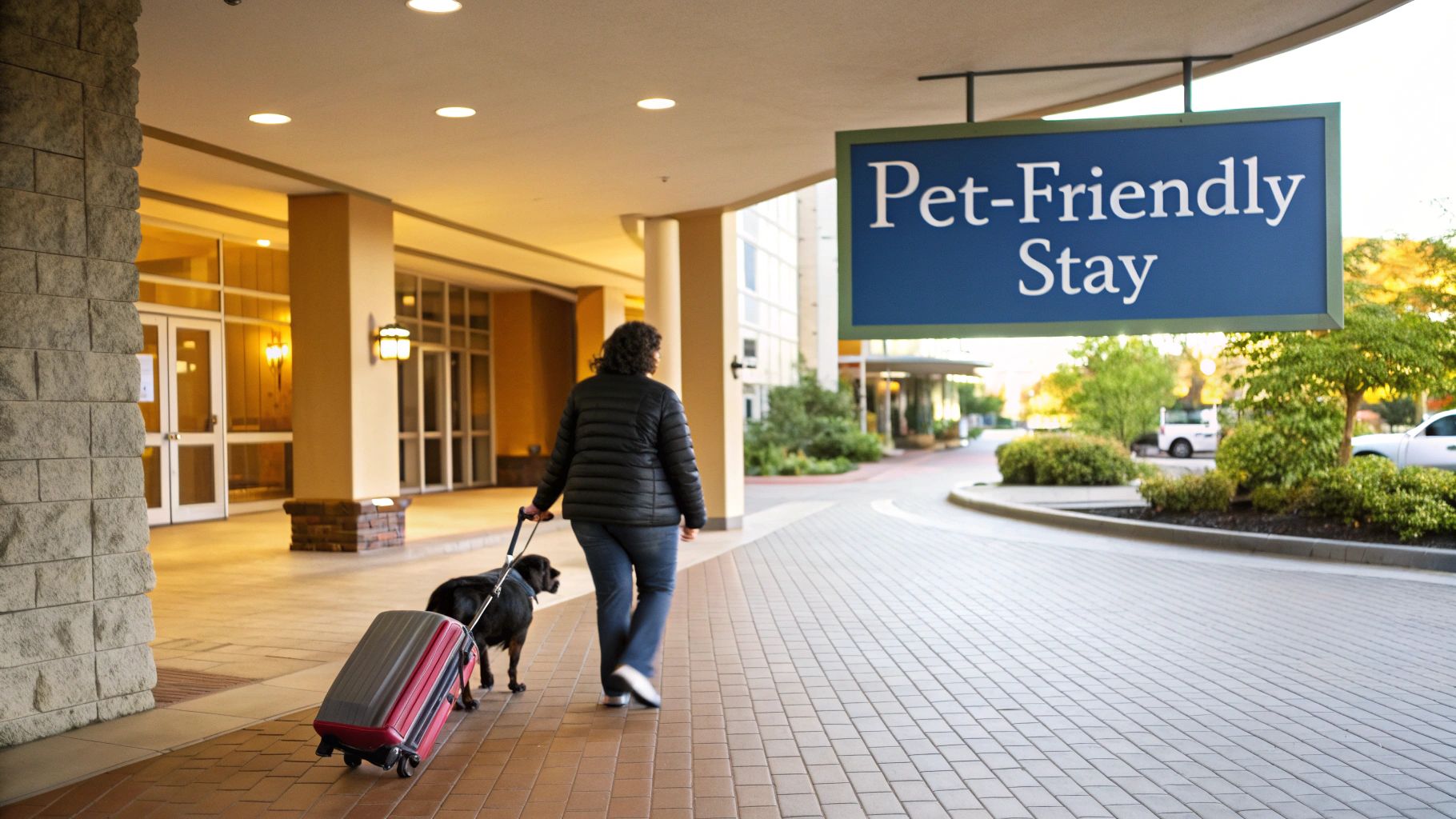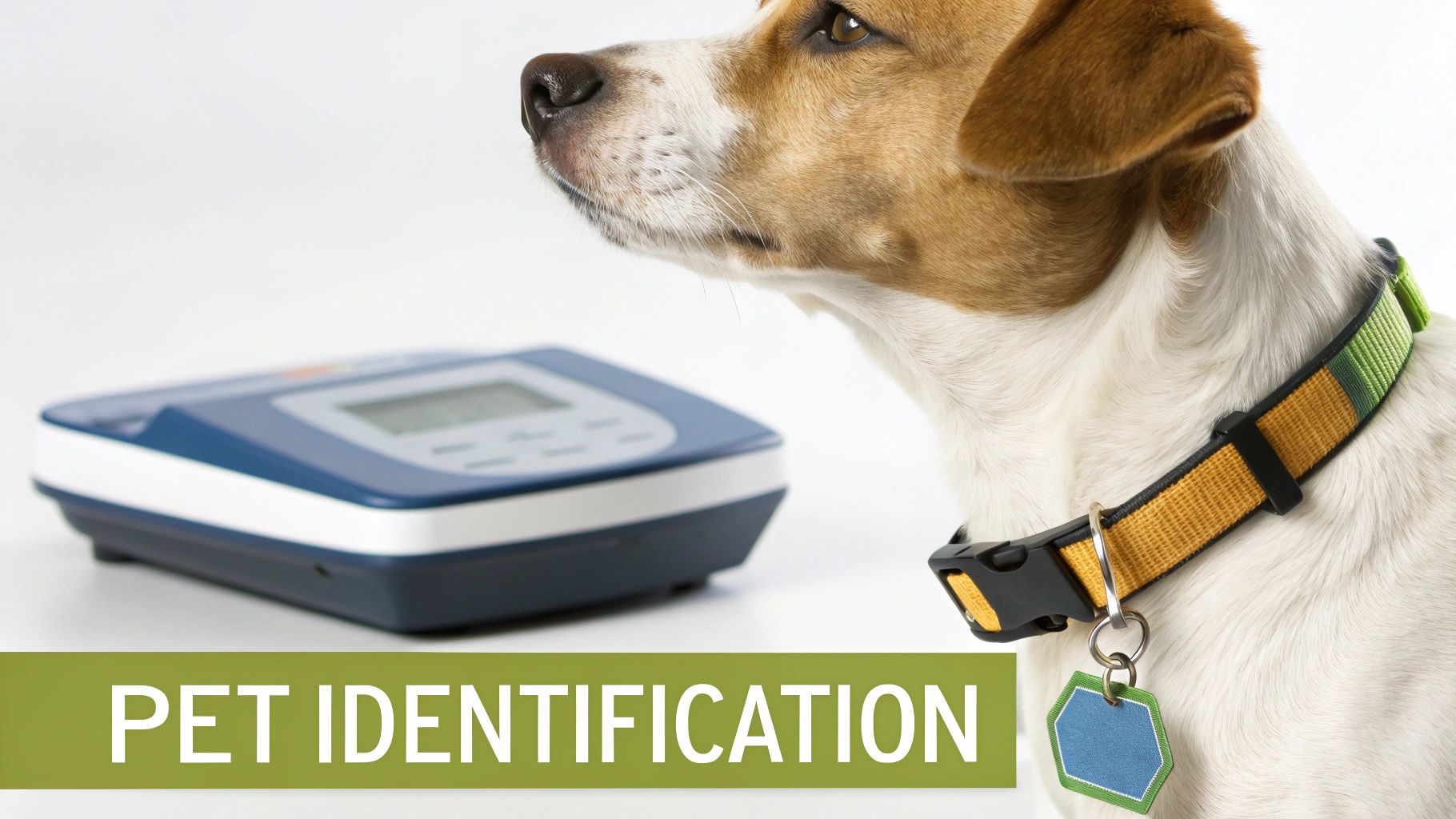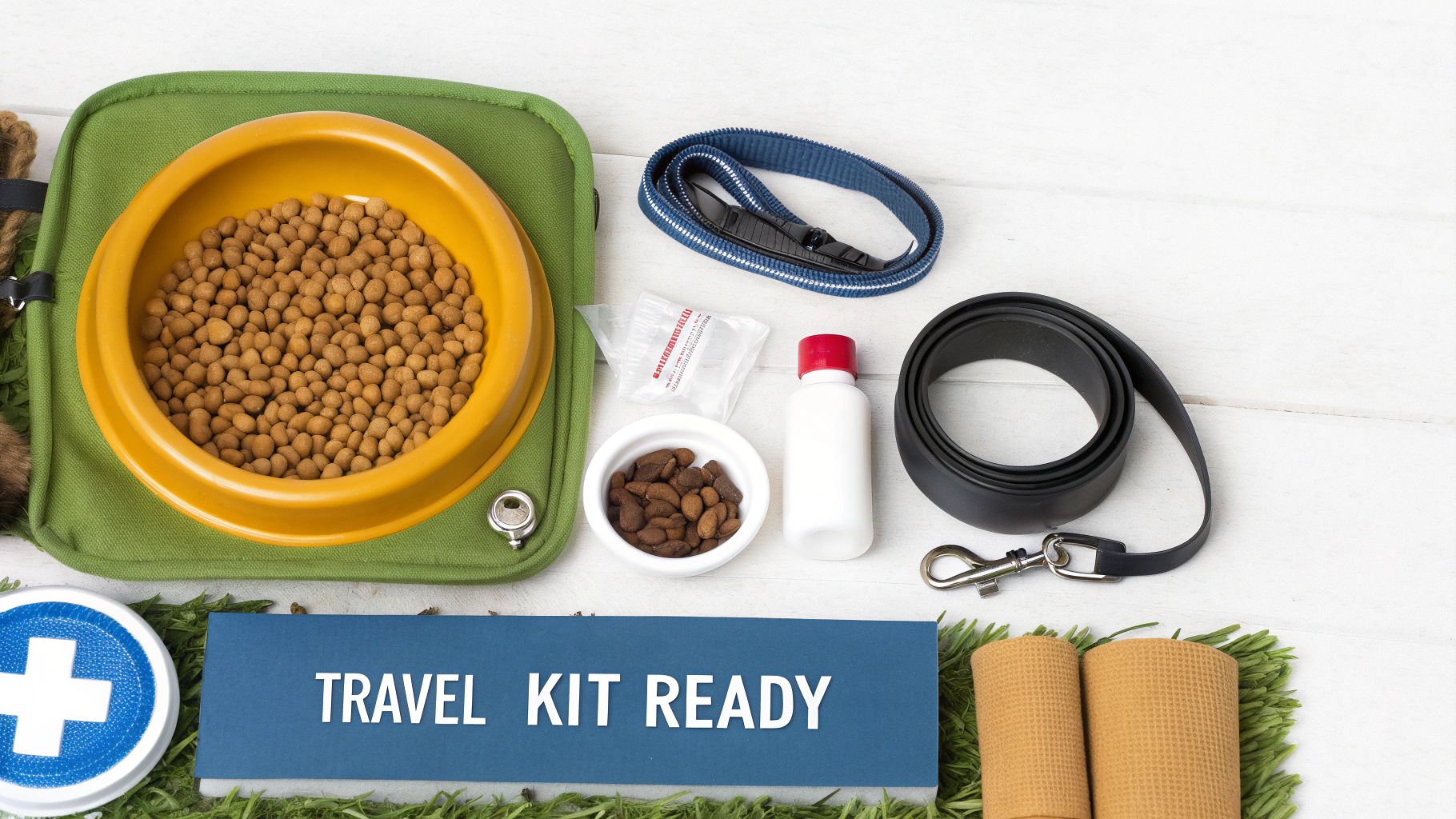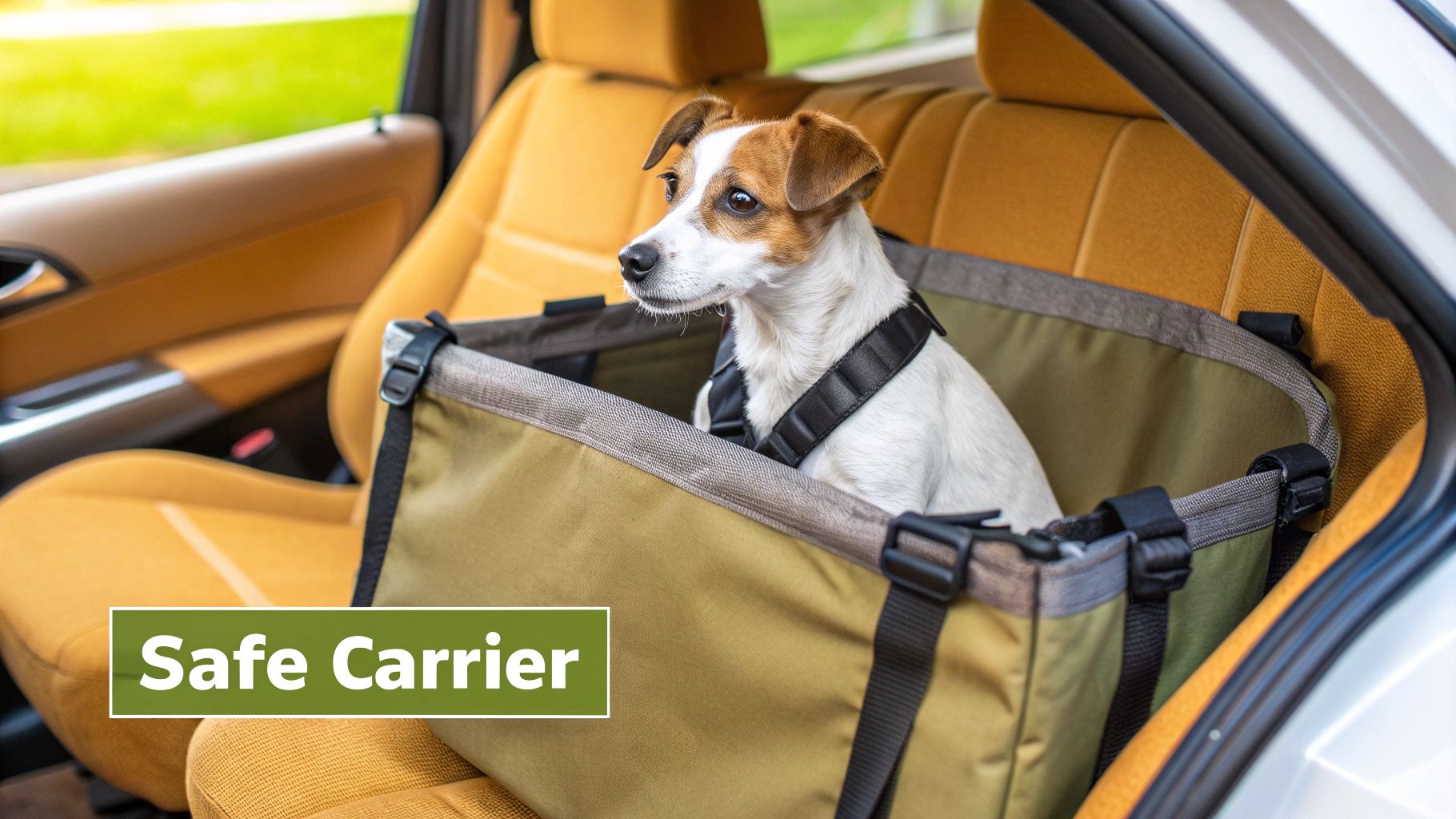Traveling with your furry companion can be one of life's most rewarding experiences, transforming a simple vacation into a shared adventure and creating memories that last a lifetime. However, a successful trip requires more than just a destination; it demands meticulous planning and preparation to ensure the journey is safe, comfortable, and stress-free for every member of the family, including the four-legged ones. Navigating complex airline policies, securing genuinely pet-welcoming accommodations, and managing your pet's health and comfort on the go can often feel like a daunting puzzle. Without the right approach, what should be an exciting getaway can quickly become a source of anxiety for both you and your pet.
This guide is designed to cut through that complexity, providing clear, actionable tips for traveling with pets that address every stage of your journey. We move beyond generic advice to offer specific strategies that you can implement immediately. Forget the guesswork and uncertainty. This comprehensive listicle will equip you with the essential knowledge needed to handle everything from pre-trip veterinarian consultations and packing the perfect travel kit to mastering the logistics of travel day itself. We cover crucial details on pet identification, choosing the right carrier or restraint system, and even how to maintain a sense of routine while exploring new places. By following these proven strategies, you can confidently plan and execute a seamless trip, ensuring your next adventure is nothing but a joy for you and your beloved co-pilot.
1. Plan Ahead and Book Pet-Friendly Accommodations
The single most crucial step for a successful trip with your furry companion is securing a guaranteed place for them to stay. Simply assuming an accommodation is "pet-friendly" can lead to last-minute cancellations, unexpected fees, or even being turned away at the front desk. This foundational planning prevents stress and ensures both you and your pet have a comfortable, welcoming home base.

This process involves more than just checking a box on a booking website. It’s about understanding the specific rules that each property enforces. A truly pet-friendly stay aligns with your pet's needs and your budget, making it one of the most important tips for traveling with pets.
How to Find and Confirm Your Stay
Start your search using dedicated platforms that simplify the process. Websites like BringFido.com are invaluable resources, offering extensive lists and user reviews of pet-welcoming hotels, vacation rentals, and even restaurants. Similarly, major booking sites like Airbnb have robust "pets allowed" filters that let you find hosts who specifically cater to animal guests, some even providing amenities like fenced yards, water bowls, and pet beds.
However, your research shouldn't end there. Always verify the policy directly with the property. A quick phone call can clarify crucial details that might be buried in the fine print.
"A booking confirmation isn't a pet confirmation. Always call the hotel directly to have them note your pet on the reservation and re-confirm their policies. This simple step can prevent major headaches upon arrival."
Actionable Tips for Booking
To ensure a seamless check-in and stay, follow these practical steps:
- Read the Fine Print: Look for specific details on weight limits, breed restrictions, the number of pets allowed per room, and any non-refundable pet fees or deposits.
- Confirm Verbally: After booking online, call the hotel's front desk. Confirm they have your pet on the reservation and ask about any designated "pet-friendly" rooms or floors.
- Screenshot Everything: Take screenshots of the pet policy on their website and save your confirmation email. Having digital proof can quickly resolve any misunderstandings.
- Research the Neighborhood: Use Google Maps to locate nearby emergency veterinary clinics, pet supply stores, and dog-friendly parks or trails. Knowing these locations in advance provides peace of mind.
2. Visit Your Veterinarian Before Traveling
A pre-travel veterinary visit is a non-negotiable step that safeguards your pet’s health and ensures you meet all legal travel requirements. This consultation confirms your pet is physically fit for the journey, up-to-date on essential vaccinations, and properly documented. Neglecting this visit can result in denied boarding, unexpected quarantine, or, worst of all, a medical emergency far from home.

This appointment is about more than just a quick check-up; it's a critical part of your travel logistics. From obtaining mandatory health certificates for flights to getting advice on managing travel-induced anxiety, your vet is an essential resource. This proactive measure is one of the most important tips for traveling with pets because it prevents health and documentation issues before they start.
How to Prepare for the Vet Appointment
To make the most of your visit, come prepared with your full travel itinerary. Your veterinarian needs to know your destination(s), mode of transport, and the duration of your trip to provide accurate advice and documentation. For example, airline travel requires a specific Certificate of Veterinary Inspection (CVI), often dated within 10 days of your flight, while international destinations may have complex vaccination and microchipping rules governed by agencies like the USDA APHIS.
Communicating these details clearly allows your vet to address any location-specific health risks, such as parasites or diseases prevalent in your destination area. Always schedule this appointment well in advance to allow time for any necessary treatments or booster shots to take full effect.
"Your pet's health certificate is their passport. Without the correct, properly dated documentation from a licensed veterinarian, your travel plans can come to an abrupt halt at the check-in counter."
Actionable Tips for Your Vet Visit
To ensure a smooth and productive appointment, follow these practical steps:
- Schedule Early: Book the appointment 2-4 weeks before your departure date. This buffer is crucial if your pet needs new vaccinations, microchipping, or time to adjust to a new medication.
- Request Extra Copies: Ask for multiple physical and digital copies of all documentation, including vaccination records and the official health certificate. Keep them in a waterproof folder with your own travel documents.
- Discuss Travel-Related Ailments: Talk to your vet about solutions for motion sickness or travel anxiety. They can recommend effective over-the-counter options, natural calming aids, or prescription medications if necessary.
- Confirm Destination Requirements: Double-check all health requirements for your destination and airline. You can find this information on the USDA APHIS pet travel website and your airline’s official policy page.
3. Ensure Proper Pet Identification
Even the most well-behaved pet can get spooked and run off in an unfamiliar environment. A solid identification strategy is a non-negotiable safety net that dramatically increases the chances of a swift and safe reunion. This multi-layered approach ensures that if your pet gets lost, anyone who finds them has multiple ways to contact you immediately.

This process combines permanent solutions like microchips with temporary, travel-specific tags and up-to-date photos. Relying on just one method is risky; a comprehensive ID plan is one of the most critical tips for traveling with pets because it provides peace of mind and a direct line back to you, no matter where you are.
How to Build a Robust ID System
Start with the basics: a durable, legible ID tag securely attached to your pet's collar or harness. This tag should include your pet's name and, most importantly, your mobile phone number. For permanent identification, a microchip is essential. This tiny transponder, implanted by a vet, contains a unique ID number linked to your contact information in a national registry. Services like HomeAgain and registries from organizations such as the Found Animals Foundation offer 24/7 recovery support, and nearly all shelters and vet clinics have universal scanners.
However, your ID system should not stop there. The final layer is visual proof: clear, recent photographs of your pet. If they go missing, these photos become invaluable for creating "lost pet" flyers and sharing on local social media groups.
"A microchip is only as good as the information it's linked to. Before any trip, log into your pet's microchip registry online and double-check that your phone number and email address are current. An outdated number can make a life-saving tool useless."
Actionable Tips for Identification
To create a foolproof identification plan for your travels, follow these practical steps:
- Create a Travel-Specific Tag: In addition to their regular ID tag, add a temporary one with your destination address and the phone number of your hotel or vacation rental.
- Take Pre-Trip Photos: Snap a few clear photos of your pet from different angles just before you leave. This captures their current appearance, including haircut and any distinguishing marks.
- Confirm Microchip Details: Log in to your microchip registry to ensure your contact information is up to date. If you've moved or changed phone numbers, update it immediately.
- Keep Digital and Physical Copies: Save your pet's photos, microchip number, and vet records to your phone and a cloud service. Also, carry a physical copy in your travel documents in case your phone battery dies.
4. Pack a Complete Pet Travel Kit
Just as you wouldn’t leave home without your own essentials, your pet requires a dedicated travel kit to ensure their comfort, health, and safety on the road. A well-organized bag prevents the stress of scrambling for food in an unfamiliar town or not having a crucial medical item when needed. This preparation helps maintain your pet's routine and allows you to handle unexpected situations with confidence.

This process goes beyond just packing a bag of kibble. It involves anticipating your pet’s needs across different environments, from a long car ride to a multi-day hotel stay. Having everything in one place is one of the most practical tips for traveling with pets, ensuring you can focus on enjoying the journey together.
How to Build the Ultimate Pet Go-Bag
Start with the absolute necessities: food, water, and medications. Use pre-portioned containers or resealable bags for food to save space and simplify feeding times. A collapsible water bowl is a travel essential, perfect for quick hydration stops during a road trip or a hike. For medications, bring them in their original prescription bottles to avoid any confusion or issues with authorities.
Beyond the basics, think about comfort and safety. A favorite blanket or toy can provide a sense of security and familiarity in a new environment, helping to reduce anxiety. For more ideas on what to include, you can learn more about how to Pack a Complete Pet Travel Kit on petvoyages.com to cover all your bases.
"Your pet's travel kit is their lifeline on the road. Pack as if you might be stranded for an extra day or two. That means extra food, water, and any critical medications. It’s better to have it and not need it than the other way around."
Actionable Tips for Packing
To ensure you have a comprehensive and well-organized kit, follow these practical steps:
- Pack Extra Supplies: Always pack at least three extra days' worth of food and any necessary medications. Travel delays are common, and you don’t want to be caught unprepared.
- Include a First-Aid Kit: Purchase a pet-specific first-aid kit or build your own with essentials like antiseptic wipes, gauze, self-adhesive bandages, and styptic powder for minor injuries.
- Organize Documentation: Keep all your pet's documents, including vaccination records, health certificates, and microchip information, in a waterproof and easily accessible folder.
- Bring Familiar Comfort Items: Include items that smell like home, such as a small bed, a favorite toy, or an old t-shirt. This can significantly ease your pet's stress in new surroundings.
5. Choose the Right Travel Carrier or Restraint System
A safe and secure pet is a happy traveler, and the cornerstone of their security is the right carrier or restraint system. This piece of equipment is not just about containment; it’s about providing a safe, comfortable, and stress-free personal space for your pet during transit. Whether you're flying across the country or driving to a nearby city, the proper system protects them from injury and ensures you comply with travel regulations.
The ideal choice depends entirely on your mode of transport, your pet's size, and their temperament. Investing in a high-quality, appropriate restraint is one of the most fundamental tips for traveling with pets, as it directly impacts their well-being and your peace of mind throughout the journey.
How to Select the Best Option
Start by identifying your primary travel method. For air travel, soft-sided carriers like those from Sherpa are often preferred for in-cabin use as they fit under seats and are approved by most major airlines. For car travel, safety is paramount. Crash-tested carriers like the Sleepypod or safety harnesses such as those made by Kurgo secure your pet to the seatbelt system, preventing them from becoming a projectile in a sudden stop.
Regardless of the type, the fit is crucial. Your pet should be able to stand up, turn around, and lie down comfortably. Always measure your pet before purchasing and compare their dimensions to the carrier's interior measurements, not the exterior.
"Your pet’s carrier is their safe haven during the chaos of travel. Introducing it weeks in advance with treats and toys transforms it from a cage into a comforting den, significantly reducing travel day anxiety."
Actionable Tips for Choosing and Using a Carrier
To ensure you make the right choice and that your pet accepts it, follow these practical steps:
- Verify Travel Requirements: Before you buy, check the specific carrier size and design requirements for your airline or train service. These can vary significantly between companies.
- Prioritize Safety and Ventilation: Look for durable materials, secure zippers or latches, and ample mesh windows for airflow. For car travel, always prioritize crash-tested products.
- Conduct a Slow Introduction: Place the carrier in your living area weeks before your trip. Encourage your pet to explore it by placing treats, toys, and familiar bedding inside, making it a positive space.
- Take Practice Trips: Start with short drives around the neighborhood to acclimate your pet to the motion and experience of being inside the carrier while in a vehicle. For an in-depth guide, you can learn more about choosing the right pet travel crates on PetVoyages.com.
6. Research Pet-Friendly Activities and Destinations
A successful trip with your pet goes beyond finding a place for them to sleep; it’s about sharing the experience. Researching pet-friendly attractions, parks, restaurants, and local policies ensures your pet can be an active participant in the vacation, not just a passenger. This proactive approach turns a good trip into a great one by creating shared memories.
Investing time in this research is one of the most rewarding tips for traveling with pets, as it maximizes enjoyment for everyone. Destinations like Carmel-by-the-Sea in California, where dogs are welcome on beaches and in many shops, or Asheville, North Carolina, known for its dog-friendly breweries and hiking trails, are built around this inclusive travel style.
How to Find and Confirm Activities
Begin your search with specialized resources designed for pet owners. Platforms like BringFido.com and DogFriendly.com offer comprehensive guides to attractions, restaurant patios, and off-leash areas in thousands of cities. These sites provide user reviews and real-time updates that are invaluable for on-the-ground planning.
However, policies can change without notice. A restaurant may temporarily close its patio, or a park might update its leash regulations. It's crucial to confirm details just before you go.
"A listing on an app is a great starting point, but a quick call to the venue is the final confirmation. Asking about their current pet rules or patio availability can save you from a wasted trip and a disappointed pet."
Actionable Tips for Planning
To build a fun and flexible itinerary that includes your furry friend, follow these steps:
- Read Local Regulations: Before you arrive, look up municipal leash laws and waste disposal rules. Some cities have strict on-leash policies even in seemingly open areas, and knowing these details prevents potential fines.
- Confirm Policies Directly: Call restaurants to verify their patio is open and pet-friendly. For attractions or parks, check their official website or social media pages for the most current information.
- Plan for All Weather: Identify both outdoor and indoor pet-friendly options. Find a coffee shop with a covered patio or a pet-friendly retail store you can browse in case of unexpected rain or extreme heat.
- Create a Pet-Centric Map: Use Google Maps to pin potential parks, eateries, and pet supply stores near your accommodation. This gives you a quick visual reference for nearby options. You can learn more about finding ideal locations with our guide to pet-friendly vacation destinations.
7. Maintain Feeding and Exercise Routines
Travel disrupts routines, but for pets, this disruption can be a significant source of anxiety and physical discomfort. Maintaining their regular feeding schedule and exercise habits provides a sense of normalcy and security in unfamiliar surroundings. This consistency is a powerful tool for managing stress and ensuring your pet remains happy and healthy throughout your journey.
Sticking to a familiar schedule helps regulate your pet’s digestion, energy levels, and bathroom needs, preventing accidents and behavioral issues. A well-fed and properly exercised pet is calmer, more adaptable, and better equipped to handle the challenges of travel, making this one of the most effective tips for traveling with pets.
How to Keep Routines on the Road
The key to success is proactive planning rather than reactive adjustments. Before you even leave, think about how you will replicate your pet’s at-home schedule. For a cross-country road trip, this means mapping out rest stops every 2-3 hours for bathroom breaks and a quick walk. For air travel, it involves carefully timing their last meal to minimize the risk of an upset stomach or motion sickness during the flight.
Once at your destination, immediately identify safe, suitable areas for exercise. A quick search for nearby dog parks, walking trails, or quiet residential streets can help you re-establish their daily walk routine without delay.
"Your pet doesn't understand time zones or travel delays, but they do understand their internal clock for meals and walks. Honoring that schedule is the best way to tell them that everything is okay, even in a new place."
Actionable Tips for Maintaining Consistency
To keep your pet comfortable and stress-free, integrate these practical steps into your travel plans:
- Pack Familiar Food: Bring enough of your pet’s regular food for the entire trip, plus a little extra. Suddenly switching brands can cause digestive upset, which is the last thing you want to deal with on vacation.
- Time Meals Strategically: For car or air travel, feed your pet a light meal about 3-4 hours before departure. This helps prevent nausea and motion sickness while ensuring they aren't traveling on an empty stomach.
- Use an Alarm: Set reminders on your phone for feeding times, walks, and medication. This is especially helpful if you are crossing time zones and your own schedule is disrupted.
- Research Local Exercise Spots: Before you arrive, use Google Maps to find dog-friendly parks, beaches, or trails near your accommodation. Knowing where you can go for a good run or walk makes it easy to stick to their exercise regimen.
8. Prepare for Travel Day Logistics and Safety
The actual day of travel can be the most stressful part of the journey for both you and your pet. Proactive planning for logistics and safety transforms potential chaos into a smooth, controlled process. This involves understanding procedures at airports or border crossings, managing your pet’s anxiety, and having solid contingency plans for unexpected delays or emergencies.
Successfully navigating travel day is about more than just getting from point A to B; it's about ensuring your pet’s well-being throughout every step. Thinking through each transition, from leaving the house to arriving at your destination, is one of the most vital tips for traveling with pets.
How to Manage Travel Day Procedures
Whether you're flying or driving, you will encounter procedures that require your full attention. For air travel, this means being prepared for security screenings and airline check-ins. For example, TSA regulations require you to remove your pet from their carrier so the carrier can be X-rayed. Similarly, airlines often require passengers with pets to check in at the counter, sometimes hours before the flight, rather than online.
For road trips, this means planning for frequent stops and being ready for potential border crossings, which often require presenting your pet’s health documents. Anticipating these steps prevents last-minute panic.
"Your pet's calm demeanor is a direct reflection of your own. By practicing logistical steps like carrier removal and staying organized, you project confidence that helps keep your animal relaxed during stressful moments."
Actionable Tips for a Smooth Journey
To ensure travel day goes off without a hitch, incorporate these practical strategies into your plan:
- Practice for Security: At home, practice taking your pet out of their carrier and holding them securely. This familiarizes them with the process and helps you manage it smoothly at a busy airport checkpoint.
- Plan Your Route and Stops: For road trips, use apps like Google Maps to pre-plan your route, identifying rest areas and pet-friendly parks for breaks every 2-3 hours.
- Keep an Emergency Kit Accessible: Your pet's travel bag should contain more than just food. Include a small first-aid kit, extra poop bags, cleaning wipes for accidents, and a copy of their medical records.
- Have Contingency Plans: Identify a 24-hour emergency vet clinic near your destination. Keep the contact information for a few backup pet-friendly accommodations in case your primary booking falls through for any reason.
8 Essential Tips for Traveling with Pets Comparison
| Item | Implementation Complexity 🔄 | Resource Requirements ⚡ | Expected Outcomes 📊 | Ideal Use Cases 💡 | Key Advantages ⭐ |
|---|---|---|---|---|---|
| Plan Ahead and Book Pet-Friendly Accommodations | Moderate: requires advance planning and research | Moderate: time for booking, possible deposits | High: secured pet-friendly lodging, less stress | Trips with fixed dates and known destinations | Reduces travel stress; better accommodation options; possible cost savings |
| Visit Your Veterinarian Before Traveling | Moderate: scheduling and vet visit needed | Moderate: vet fees and time | High: pet health confirmation and regulatory compliance | Interstate/international travel requiring health clearance | Peace of mind; compliance with regulations; early health issue detection |
| Ensure Proper Pet Identification | Low: one-time setup with ongoing updates | Low to moderate: microchip cost, tags, photo management | High: increased chance of pet recovery | Any travel where pet could get lost | Permanent ID; multiple recovery methods; peace of mind |
| Pack a Complete Pet Travel Kit | Moderate: gathering and organizing items | Moderate to high: cost and space for supplies | High: comfort, preparedness, and emergency readiness | All travel types, especially extended or remote trips | Maintains routine; emergency preparedness; reduces stress |
| Choose the Right Travel Carrier or Restraint System | Moderate to high: selecting and acclimating pet | Moderate to high: purchase of certified carriers or restraints | Very high: pet safety and comfort during transport | Air travel, vehicle travel, and regulated transport modes | Ensures pet safety; compliance with regulations; reduces pet anxiety |
| Research Pet-Friendly Activities and Destinations | Moderate to high: time-consuming research | Low to moderate: time investment | High: inclusive and enjoyable vacation experiences | Leisure trips aiming for pet inclusion | Prevents surprises; ensures pet engagement; maximizes experience |
| Maintain Feeding and Exercise Routines | Moderate: adapting schedules during travel | Low: requires planning and access to resources | High: reduces stress, maintains health and behavior | Trips with longer duration or varying environments | Reduces stress; maintains health; prevents behavioral issues |
| Prepare for Travel Day Logistics and Safety | High: extensive preparation and contingency plans | Moderate: time, possible extra costs | High: smooth transitions; safety and stress reduction | Any complex travel day involving security or multiple legs | Minimizes delays; reduces stress; handles emergencies effectively |
Start Your Next Adventure with Confidence
Embarking on a journey with your furry companion transforms a simple vacation into a shared adventure, creating memories that last a lifetime. Navigating the world of pet travel can seem daunting at first, but as we've explored, success lies in diligent preparation and thoughtful execution. By breaking down the process into manageable steps, you can confidently manage every aspect of your trip, ensuring a safe, comfortable, and enjoyable experience for everyone involved. The comprehensive tips for traveling with pets detailed throughout this guide are not just suggestions; they are a strategic roadmap to stress-free exploration.
Recapping our journey, we've covered the critical pillars of pet travel preparedness. It all begins with proactive planning, from securing genuinely pet-welcoming accommodations to scheduling that vital pre-trip veterinary check-up. We emphasized the non-negotiable importance of proper identification, a simple step that provides an essential safety net. Furthermore, we detailed how to assemble a comprehensive travel kit, select the ideal carrier or restraint system, and research pet-friendly destinations, transforming potential challenges into opportunities for fun.
From Preparation to Paws on the Ground
The true value of these strategies is realized when you move from planning to action. The difference between a chaotic trip and a calm one often comes down to the small details. Maintaining your pet's routine, for example, provides a sense of normalcy and security amidst the new sights and sounds of travel. Similarly, understanding the specific logistics of your travel day, whether navigating a busy airport or planning rest stops on a long drive, empowers you to handle any situation with grace.
Here are the most critical takeaways to lock in before you go:
- Veterinary Clearance is Paramount: Your pet's health and safety come first. A clean bill of health and up-to-date documentation prevent logistical nightmares and ensure your pet is fit for the journey.
- Identification is Your Lifeline: Never underestimate the power of a microchip and a collar with clear, current contact information. This is your single most important safety tool.
- Comfort is Key: A well-ventilated, appropriately sized carrier or a secure harness isn't just a rule to follow; it's a crucial component of your pet's physical and emotional well-being during transit.
- Routine Reduces Stress: Consistency in feeding times, exercise, and potty breaks provides a comforting anchor for your pet, helping them adapt more easily to new environments.
Mastering these tips for traveling with pets does more than just prevent problems; it deepens the bond you share with your animal. When your pet feels secure and cared for, they can relax and enjoy the new experiences alongside you. This proactive approach transforms you from a pet owner into a confident and capable travel guardian, ready to lead your loyal companion on any adventure. The goal is not just to bring your pet along but to create an integrated travel experience where their needs are anticipated and met with the same care as your own. Your next great escape awaits, and now you have the knowledge to make it a resounding success.
Ready to put these plans into action with the right gear? At Pet Voyages, we create premium, airline-approved carriers and road trip essentials designed for safety, comfort, and style. Explore our collections at Pet Voyages and equip your furry co-pilot for the journey ahead.

